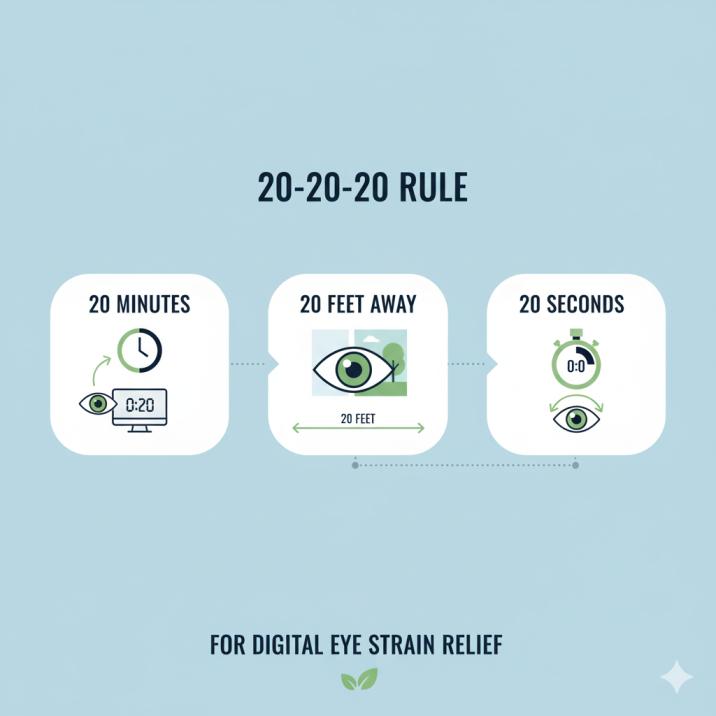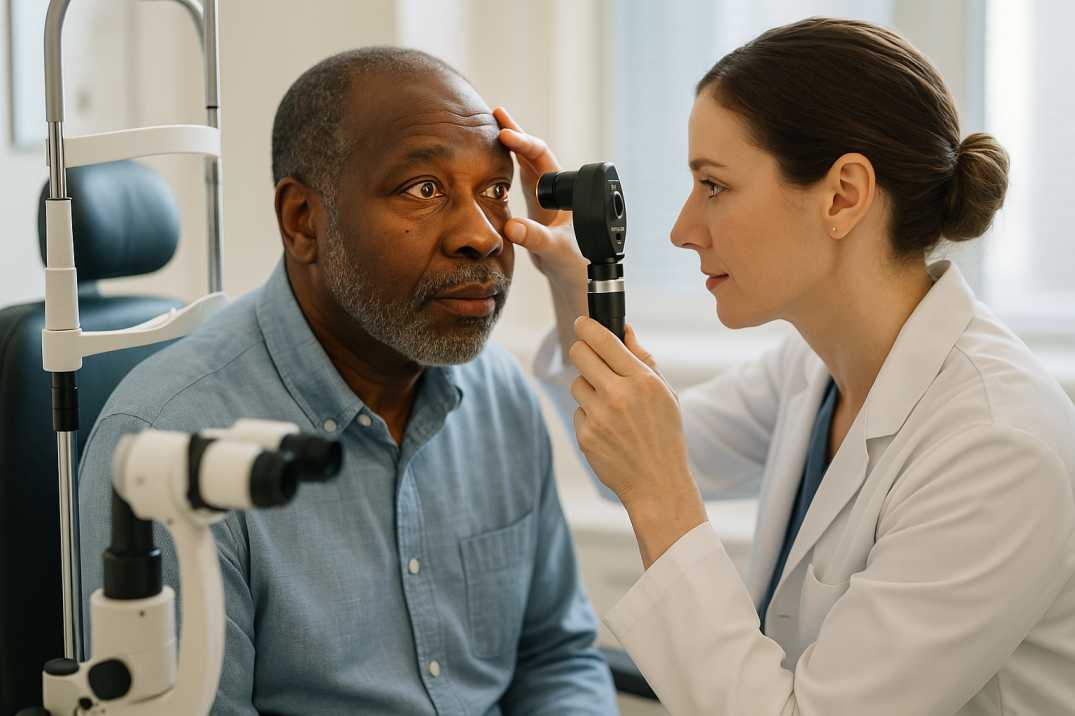Eyes Getting Worse From Home? Expert Seattle Eye Care
A comprehensive guide to understanding digital eye strain, protecting your vision, and knowing when to seek professional care
The Bottom Line: It’s Not Just You:
If you’ve noticed your eyesight worsening since transitioning to remote work, you’re definitely not alone. The latest 2025 research from VSP Vision Care shows that 68% of employees experience digital eye strain symptoms, including blurred vision, eye strain, and dry, itchy eyes, with the average employee now getting 97 hours of screen time per week (nearly 14 hours daily). At Cannon EyeCare, we’ve seen a significant increase in patients experiencing digital eye strain symptoms, and we want you to understand what’s happening to your eyes and how to protect them.
The short answer: Your eyes likely aren’t permanently damaged, but they are experiencing unprecedented strain that requires attention and care.
Understanding the Work-From-Home Vision Crisis
The Scale of the Problem
A comprehensive meta-analysis of 103 studies involving 66,577 participants found that approximately 66% of people experience some degree of computer vision syndrome. This isn’t a minor inconvenience—it’s become what experts are calling “the number one occupational hazard for knowledge workers of the 21st century.”
New research reveals that American workers begin experiencing eye strain symptoms just 27 minutes into virtual meetings, with 71% of those attending reporting blurry vision (38%), dry eyes (37%), and headaches (32%).
Why Working From Home Is Harder on Your Eyes
Increased Screen Time Without Breaks Current research shows employees are averaging 97 hours of screen time per week (nearly 14 hours daily), with more than a third of that time coming from work. Unlike traditional offices, where natural breaks occur through meetings, coffee runs, or conversations with colleagues, home workers often remain glued to their screens for hours without meaningful visual breaks.
Suboptimal Home Workspaces Home offices typically lack the ergonomic design of professional workspaces, with problems including poor lighting, glare from windows, inadequate monitor positioning, and uncomfortable seating arrangements. Many people work on laptops with smaller screens, forcing them to lean closer and strain their eyes more than they would with properly positioned monitors.
The Multi-Screen Reality Today’s workers juggle an average of four different screens daily, with 32% experiencing “screen fatigue” at least once per day and 18% struggling with it multiple times daily. Recent research shows that 59% of employees report that digital eye strain affects their productivity and effectiveness at work.
What’s Actually Happening to Your Eyes: The Science Behind Digital Eye Strain
Computer Vision Syndrome Explained
Computer vision syndrome (CVS), also known as digital eye strain, is a group of eye and vision-related problems resulting from prolonged use of digital devices. The extent to which individuals experience symptoms depends on their visual abilities and the amount of time spent looking at screens.
Why Screens Are Uniquely Challenging for Your Eyes
When you work at a computer, your eyes must constantly focus and refocus as they move back and forth while reading. Unlike books or paper, screens add contrast, flicker, and glare, making your eye muscles work significantly harder. Additionally, we blink far less frequently when using computers, causing our eyes to dry out and vision to blur periodically.
The Blinking Problem
Staring at screens causes people to blink up to 66% less often than normal. Blinking is essential for hydrating your eyes and stimulating oil release from tiny eyelid glands, preventing tears from evaporating too quickly. This dramatic reduction in blinking is a primary contributor to the dry, irritated eyes so many remote workers experience.
Blue Light and Eye Strain
Blue light has the shortest wavelength and highest energy in the visible light spectrum, easily reaching the retina and contributing to eye strain. Working from home exposes eyes to high amounts of blue light from computer screens for extended periods.
Common Symptoms: Is This What You’re Experiencing?
Primary Visual Symptoms
- Blurry vision, especially after extended screen time
- Difficulty focusing on objects at different distances
- Double vision or seeing “halos” around text
- Eye strain and fatigue that worsen throughout the day
Physical Discomfort
- Dry, burning, or gritty eyes
- Excessive tearing (your eyes overcompensating for dryness)
- Red, irritated eyes
- Increased light sensitivity
Secondary Effects
- Headaches, particularly behind the eyes or at the temples
- Neck and shoulder pain from poor posture
- General fatigue and difficulty concentrating
- Sleep disruption from blue light exposure
The Critical Question: Are These Changes Permanent?
The Reassuring Truth About Digital Eye Strain
According to leading digital eye strain researcher Dr. Amy Sheppard from Aston School of Optometry, symptoms of digital eye strain can be frequent, making it feel like eyes are getting worse daily. However, because people are on screens for so long every day, blurry vision may never get a chance to fully resolve, creating the illusion of permanent vision deterioration when what’s really needed is adequate rest.
The key insight: While eye strain symptoms are uncomfortable, they don’t permanently damage your eyes or vision. Most symptoms are temporary and reversible with proper care and breaks from screen time.
When Pre-Existing Conditions Become More Noticeable
If you already wear glasses or contacts, increased computer time can make a slightly off prescription more noticeable and uncomfortable, prompting you to seek an updated prescription. Uncorrected vision problems like farsightedness and astigmatism, inadequate eye focusing abilities, and aging-related changes can all contribute to more severe symptoms when using digital devices.
Evidence-Based Solutions: What Actually Works
The 20-20-20 Rule and Beyond
The foundational strategy recommended by eye care professionals is the 20-20-20 rule: every 20 minutes, look at something 20 feet away for 20 seconds. Research has found that looking at distant objects during work breaks can significantly reduce computer vision syndrome symptoms.
For families with children: Children should follow the 20-20-20-2 rule, which adds two hours of outdoor play daily to support proper eye development.
Optimizing Your Home Workspace
Monitor Positioning Position your monitor slightly below eye level, about 20 to 28 inches from your face. You shouldn’t have to stretch your neck or strain your eyes to see the screen clearly.
Lighting Solutions: Position your desk perpendicular to windows to maximize natural light while minimizing glare. Avoid overhead lighting that creates reflections on your screen. Control excessive light from windows by closing or shielding them, and switch off fluorescent lights that cause glare.
Screen Settings Adjust brightness, contrast, and font size until you find what’s most comfortable. Don’t settle for factory presets if they cause strain.
Professional Eye Exercises That Work
Focus Shifting Exercises Professional vision therapists recommend isometric eye holds using a clock pattern: look at each “hour” position, hold for five seconds, then return to the center. This provides full-range eye movement and strengthens extraocular muscles.
Coordination Training Practice: quick focus switches between near and far objects using your fingers at different distances. This trains the coordination and strength of your eye muscles.
Blinking Exercises: Consciously practice rapid blinking exercises: blink rapidly for several seconds, then close your eyes and relax. This helps restore the tear film that computer use disrupts.
Palming Technique: Rub your palms together to generate warmth, then place them gently over closed eyes. This helps relax strained eye muscles and provides soothing relief.
When to Seek Professional Eye Care
Red Flags That Require Immediate Attention
While most digital eye strain is temporary, certain symptoms warrant professional evaluation:
- Persistent blurry vision that doesn’t improve with rest
- Severe headaches that interfere with daily activities
- Sudden changes in vision quality or clarity
- Eye pain, rather than just fatigue or strain
- Symptoms that continue even when away from screens
The Value of Professional Assessment
A comprehensive vision examination with a specialist is essential for proper diagnosis, as these symptoms can occur in people with 20/20 vision and may indicate other underlying conditions that standard eye tests don’t detect.
What to Expect During Your Visit. At Cannon EyeCare, we conduct specialized testing focused on your specific working distances and visual demands. Our comprehensive evaluation includes assessment of visual function at computer viewing distances and detection of any untreated vision problems that could be contributing to or masquerading as computer vision syndrome.
The Cannon EyeCare Approach: Comprehensive Care for the Digital Age
Our Philosophy
At Cannon EyeCare, we believe in treating the whole person, not just the symptoms. Our approach combines the latest diagnostic technology with the unhurried, thorough attention that’s become our hallmark in Seattle’s University Village and Pike Place Market locations.
Specialized Services for Remote Workers
- Computer vision syndrome evaluations tailored to your specific work setup
- Workplace ergonomics consultations to optimize your home office
- Prescription adjustments for computer-specific viewing distances
- Dry eye therapy using the latest treatments and technologies
- Blue light filtering lens options when clinically appropriate
Why Choose Comprehensive Care
Even minor vision problems can disrupt worker productivity by at least 20%. By addressing the root causes of your eye strain—not just the symptoms—we help ensure your long-term visual health and work performance.
Latest Research: Three Key Studies Supporting Professional Eye Care
Study 1: Digital Eye Strain Prevalence
A 2024 study published in Contact Lens and Anterior Eye found that 62.6% of working adults in the UK and Ireland experience digital eye strain, with symptoms most likely to occur in remote workers. The study revealed that 8.1% of respondents considered their symptoms significant enough to affect their work performance.
Study 2: Myopia Progression During COVID-19
Research published in PMC documented that myopia prevalence reached nearly 50% during the COVID era, with progression accelerating from 0.3D pre-COVID to 1D during the pandemic, with maximum impact seen in children aged 6-8 years.
Study 3: 2025 VSP Vision Research on Virtual Meeting Eye Strain
A 2025 study by OnePoll and VSP Vision found that American workers begin experiencing eye strain symptoms just 27 minutes into virtual meetings, with 71% reporting they attend virtual meetings and experiencing blurry vision (38%), dry eyes (37%), and headaches (32%).
Note: All statistics in this article have been verified against the most current 2025 research and peer-reviewed studies to ensure accuracy.
Protecting Your Vision: A Comprehensive Action Plan
Immediate Steps (Start Today)
- Implement the 20-20-20 rule during all screen work
- Adjust your workspace for proper monitor height and lighting
- Increase font sizes and screen brightness to reduce strain
- Practice conscious blinking throughout your workday
- Use artificial tears if you experience dry eyes
Weekly Habits
- Conduct workspace audits to identify and fix ergonomic issues
- Practice eye exercises for 5-10 minutes daily
- Limit recreational screen time to give your eyes additional rest
- Assess your symptoms and track improvements
Professional Care Timeline
- Annual comprehensive eye exams for prevention and early detection
- Immediate consultation if you experience persistent or worsening symptoms
- Follow-up visits as recommended based on your individual risk factors
The Future of Eye Health in a Digital World
Emerging Trends and Solutions
As we move into 2025, personalized eyewear solutions, advanced blue light protection, and preventive eye health monitoring are becoming increasingly important for maintaining visual comfort in our digital-first world.
Technology and Prevention
New developments include smart contact lenses for real-time eye health monitoring, wearable eye trackers for early disease detection, and at-home monitoring devices that can track intraocular pressure and vision changes.
Key Resources and Citations
The information in this article is based on current peer-reviewed research and authoritative sources. Here are three essential resources for further reading:
1. American Optometric Association – Computer Vision Syndrome
Source: American Optometric Association (AOA)
Link: https://www.aoa.org/healthy-eyes/eye-and-vision-conditions/computer-vision-syndrome
Key Finding: Comprehensive overview of computer vision syndrome, including the fact that the average American worker spends seven hours daily on computers and that symptoms can persist even after stopping computer work if underlying causes aren’t addressed.
2. VSP Vision Care – 2025 Workplace Vision Health Report
Source: VSP Vision Care and Workplace Intelligence
Link: https://vspvision.com/newsroom/eye-health-and-wellness/vision-care/New-Research-from-OnePoll-and-VSP-Vision-finds-American-workers-begin-to-experience-eye-strain-in-virtual-meetings-within-27-minutes
Key Finding: Current research shows that 68% of employees experience digital eye strain symptoms, workers average 97 hours of screen time weekly, and eye strain symptoms begin just 27 minutes into virtual meetings.
3. Systematic Review on Computer Vision Syndrome Prevalence
Source: Journal of Optometry – Systematic Review and Meta-Analysis
Link: https://www.journalofoptometry.org/en-prevalence-computer-vision-syndrome-a-articulo-S1888429623000304
Key Finding: Meta-analysis of 103 cross-sectional studies with 66,577 participants found that approximately 66% of people experience computer vision syndrome, establishing it as a significant public health concern.
These sources provide the scientific foundation for the recommendations and statistics presented in this article. For additional clinical guidance specific to your situation, consult with a qualified eye care professional.
Conclusion: Your Eyes Deserve Professional Attention
The transition to remote work has created unprecedented challenges for eye health, but the effects don’t have to be permanent or progressive. While digital eye strain symptoms cause discomfort, they are temporary and will resolve with proper care and adjusted screen habits.
The key takeaway: Your eyes are likely responding normally to abnormal conditions. With proper care, professional guidance, and evidence-based strategies, you can protect your vision and work comfortably in our digital world.
At Cannon EyeCare, we’re here to help you navigate these challenges with the expertise and personalized attention you deserve. Because when it comes to your vision, professional care makes all the difference.
Ready to Protect Your Vision?
If you’re experiencing any of the symptoms described in this article, don’t wait for them to worsen. Schedule a comprehensive eye examination with our experienced team at Cannon EyeCare. We’re conveniently located in University Village and Pike Place Market, and we accept most major insurance plans.
Contact Information:
Experience the Cannon EyeCare difference—where Midwestern hospitality meets expert eye care in the heart of Seattle.
FAQs
-
Remote work increases screen time by 2.5+ hours daily, causing computer vision syndrome with symptoms like blurred vision, dry eyes, and headaches due to prolonged digital device exposure and reduced blinking.




